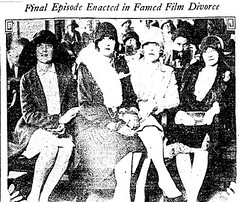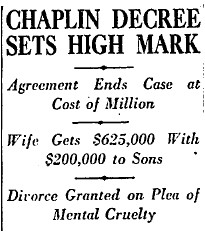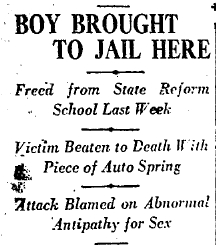 Hollywood divorces may be ugly today, but the dissolution of the legal bonds between Charlie Chaplin and his child bride, Lita Grey, may have been nastier than K-Fed and Britney, Alec and Kim, and Loni and Burt put together.
Hollywood divorces may be ugly today, but the dissolution of the legal bonds between Charlie Chaplin and his child bride, Lita Grey, may have been nastier than K-Fed and Britney, Alec and Kim, and Loni and Burt put together.
After divorce proceedings that had dragged on for nearly a year, Chaplin and Grey settled out of court today for the staggering sum of nearly $1 million ($11,971,200 USD 2007). $625,000 went to Lita, $200,000 was used to set up trust funds for the couple’s two babies, and the rest went towards assorted legal and court fees. She lost the house, but got custody of the children. It was, in 1927, the largest divorce settlement ever paid in California history.
Lita was only 18, but she was either exceptionally shrewd or exceptionally wronged.
Wed in Mexico in November 1924, Lita moved out almost exactly two years later. However, the marriage was in trouble quite literally from the beginning.
 In her nearly 50-page formal complaint against Chaplin, Grey leveled the following accusations: he’d forced her to have sex with him before they were married; he’d told her to get an abortion when he discovered she was pregnant; on their way back to Los Angeles after their wedding, he told her, “This marriage won’t last long. I’ll make you so — sick of me that you won’t want to live with me”; accused her of forcing him into marriage; had an affair with a prominent motion picture actress; told her she was stupid; encouraged her to commit suicide; only took her out 3-4 times during the first two months of their marriage “for the sake of appearances”; left her alone on Christmas while he went out and got drunk; threatened her life twice with a loaded revolver; and since their separation, had only given her $27 for milk for the babies.
In her nearly 50-page formal complaint against Chaplin, Grey leveled the following accusations: he’d forced her to have sex with him before they were married; he’d told her to get an abortion when he discovered she was pregnant; on their way back to Los Angeles after their wedding, he told her, “This marriage won’t last long. I’ll make you so — sick of me that you won’t want to live with me”; accused her of forcing him into marriage; had an affair with a prominent motion picture actress; told her she was stupid; encouraged her to commit suicide; only took her out 3-4 times during the first two months of their marriage “for the sake of appearances”; left her alone on Christmas while he went out and got drunk; threatened her life twice with a loaded revolver; and since their separation, had only given her $27 for milk for the babies.
Apparently, Chaplin decided the money was worth his peace of mind – he didn’t even show up in court. Earlier in the year, Chaplin had filed a cross-complaint that denied many of Grey’s charges, and accused her of excessive partying, relationships with other men, and negligent parenting; however, this complaint was dismissed at the time of the settlement.




 Today, 16-year-old Durward Wittenmeyer confessed to the murder of Fannie Weigel, the wife of a Pomona confectioner. It was just a few days since his release from the Whittier State School, a reformatory. The emotionally disturbed Wittenmeyer said that on his way home from the movies on May 28, he picked up an automobile spring leaf from a scrap heap, and "got a funny notion to hit someone." He saw Weigel walking home from the confectionery story, laden with bundles, and struck her twice in the side of the head. And what was the offense that had previously landed Wittenmeyer in juvie? Throwing a rock at a woman’s head in 1924.
Today, 16-year-old Durward Wittenmeyer confessed to the murder of Fannie Weigel, the wife of a Pomona confectioner. It was just a few days since his release from the Whittier State School, a reformatory. The emotionally disturbed Wittenmeyer said that on his way home from the movies on May 28, he picked up an automobile spring leaf from a scrap heap, and "got a funny notion to hit someone." He saw Weigel walking home from the confectionery story, laden with bundles, and struck her twice in the side of the head. And what was the offense that had previously landed Wittenmeyer in juvie? Throwing a rock at a woman’s head in 1924.


 Accused of stealing four cows from Lancaster rancher J.L. Armstrong, Percy Sweet, Samuel Thomason, and Chalice Thomason first came to trial early in 1927. Due to some uncertainty about the physical appearance of the stolen cows, however, the jury was unable to reach a verdict for the suspected cattle rustlers.
Accused of stealing four cows from Lancaster rancher J.L. Armstrong, Percy Sweet, Samuel Thomason, and Chalice Thomason first came to trial early in 1927. Due to some uncertainty about the physical appearance of the stolen cows, however, the jury was unable to reach a verdict for the suspected cattle rustlers.